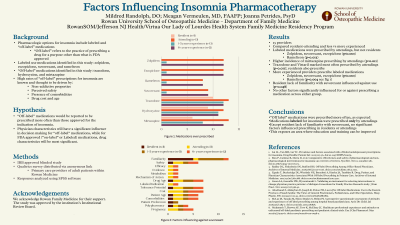Back

Clinical: General Topics
Factors influencing insomnia pharmacotherapy
Friday, March 31, 2023
12:00 PM East Coast USA Time

- MR
Mildred B. Randolph, DO (she/her/hers)
Rowan School of Osteopathic Medicine
Yeadon, Pennsylvania, United States
Presenting Author(s)
Background and Hypothesis: Pharmacologic options to treat insomnia include FDA approved medications labeled for this use as well as medications used “off-label.” Approved medications included in this study were zolpidem, eszopiclone, suvorexant, and ramelteon while trazodone, hydroxyzine, and mirtazapine were off-label. Our hypotheses were that (1) off label medications would be reported to be prescribed more often than those approved for the indication of insomnia and (2) physician characteristics will have more of a significant influence in decision making for off label medications, while for on label medications, drug characteristics will be most significant.
Methods: This blinded study was conducted through a Qualtrics survey distributed via anonymous link to primary care providers of adult patients within Rowan Medicine. Responses were analyzed using SPSS software.
Results: There were 25 respondents, composed of 23 DOs, 1 MD, and 1 NP. Prescribing habits and factors were compared between 11 residents and 13 attendings as well as between those with 1-5 years of experience vs 6 or more years. Labeled medications were prescribed by attendings, but not residents (zolpidem p< 0.001, suvorexant p< 0.001, ramelteon p=0.013, eszopiclone p< 0.001). Both residents and attendings prescribed mirtazapine, but there was a significantly higher incidence with attendings (p=0.011). Trazodone and vistaril were prescribed equally among both groups (not significant), but it was marked most often prescribed in the attending group (p=0.011). When comparing less experienced (1-5 years) to more experienced (6+ years) providers, findings were similar, with the more experienced prescribing zolpidem (p < 0.001), suvorexant (p < 0.001), eszopiclone (p < 0.001), and ramelteon (p=0.004). Other medications were not significant. Residents’ lack of familiarity with suvorexant influenced against use (p=0.048). No other factors significantly influenced for or against prescribing a medication across either resident-attending or less-more experienced groups.
Conclusion: The off label medications were the most frequently prescribed pharmacotherapy for insomnia, which was as expected. Medications labeled for use for insomnia were prescribed only by attendings. However, except for resident lack of familiarity with suvorexant, there were no significant factors influencing prescribing.
Acknowledgement of Research Study Sponsors and IRB: This study was approved by the Rowan University Institutional Review Board.
Methods: This blinded study was conducted through a Qualtrics survey distributed via anonymous link to primary care providers of adult patients within Rowan Medicine. Responses were analyzed using SPSS software.
Results: There were 25 respondents, composed of 23 DOs, 1 MD, and 1 NP. Prescribing habits and factors were compared between 11 residents and 13 attendings as well as between those with 1-5 years of experience vs 6 or more years. Labeled medications were prescribed by attendings, but not residents (zolpidem p< 0.001, suvorexant p< 0.001, ramelteon p=0.013, eszopiclone p< 0.001). Both residents and attendings prescribed mirtazapine, but there was a significantly higher incidence with attendings (p=0.011). Trazodone and vistaril were prescribed equally among both groups (not significant), but it was marked most often prescribed in the attending group (p=0.011). When comparing less experienced (1-5 years) to more experienced (6+ years) providers, findings were similar, with the more experienced prescribing zolpidem (p < 0.001), suvorexant (p < 0.001), eszopiclone (p < 0.001), and ramelteon (p=0.004). Other medications were not significant. Residents’ lack of familiarity with suvorexant influenced against use (p=0.048). No other factors significantly influenced for or against prescribing a medication across either resident-attending or less-more experienced groups.
Conclusion: The off label medications were the most frequently prescribed pharmacotherapy for insomnia, which was as expected. Medications labeled for use for insomnia were prescribed only by attendings. However, except for resident lack of familiarity with suvorexant, there were no significant factors influencing prescribing.
Acknowledgement of Research Study Sponsors and IRB: This study was approved by the Rowan University Institutional Review Board.
